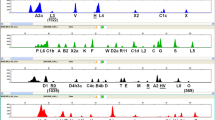Abstract
Sequence variation of the hypervariable segments (HVS) I/II of mitochondrial DNA (mtDNA) and the haplogroup affiliation were determined in a sample of 271 Italian subjects. This analysis showed that 42% of the individuals could be ascribed to H, the most frequent haplogroup in European Caucasian populations. This fraction was then screened for specific single nucleotide polymorphisms located in the coding region to identify H subclades H1–H15. We set up two multiplex polymerase chain reactions and specific SNaPshot assays to investigate the frequency distribution of these subgroups in our population sample and to examine their usefulness in discriminating among commonly shared HVS I/II sequences. This allowed the assignment of a large portion of the mtDNAs (∼70%) to specific subhaplogroups, with H1 and H5 being the most represented. About two-thirds of the individuals sharing common HVS I/II sequences were subdivided and ascribed to specific H subhaplogroups with a significant reduction of the frequencies of the most common mtDNA haplotypes. Haplogroup H subtyping could thus be extremely useful in forensic identification when many samples have to be analysed and compared, avoiding excessive time-consuming and labor-intensive sequencing analysis.

Similar content being viewed by others
References
Torroni A, Lott MT, Cabell MF, Chen YS, Lavergne L, Wallace DC (1994) mtDNA and the origin of Caucasians: identification of ancient Caucasian-specific haplogroups, one of which is prone to a recurrent somatic duplication in the D-loop region. Am J Hum Genet 55:760–776
Krings M, Stone A, Schmitz RW, Krainitzki H, Stoneking M, Paabo S (1997) Neanderthal DNA sequences and the origin of modern humans. Cell 90:19–30
Ingman M, Kaessmann H, Paabo S, Gyllensten U (2000) Mitochondrial genome variation and the origin of modern humans. Nature 408:708–713
Taylor RW, Turnbull DM (2005) Mitochondrial DNA mutations in human disease. Nat Rev Genet 6:389–402
Budowle B, Wilson MR, DiZinno JA, Stauffer C, Fasano MA, Holland MM, Monson KL (1999) Mitochondrial DNA regions HVI and HVII population data. Forensic Sci Int 103:23–35
Richards M, Macaulay V, Hickey E et al. (2000) Tracing European founder lineages in the Near Eastern mtDNA pool. Am J Hum Genet 67:1251–1276
Brandstatter A, Parsons TJ, Parson W (2003) Rapid screening of mtDNA coding region SNPs for the identification of west European Caucasian haplogroups. Int J Legal Med 117:291–298
Quintans B, Alvarez-Iglesias V, Salas A, Phillips C, Lareu MV, Carracedo A (2004) Typing of mitochondrial DNA coding region SNPs of forensic and anthropological interest using SNaPshot minisequencing. Forensic Sci Int 140:251–257
Coble MD, Just RS, O’Callaghan JE, Letmanyi IH, Peterson CT, Irwin JA, Parsons TJ (2004) Single nucleotide polymorphisms over the entire mtDNA genome that increase the power of forensic testing in Caucasians. Int J Legal Med 118:137–146
Loogvali EL, Roostalu U, Malyarchuk BA et al. (2004) Disuniting uniformity: a pied cladistic canvas of mtDNA haplogroup H in Eurasia. Mol Biol Evol 21:2012–2021
Pereira L, Richards M, Goios A et al. (2005) High-resolution mtDNA evidence for the late-glacial resettlement of Europe from an Iberian refugium. Genome Res 15:19–24
Achilli A, Rengo C, Magri C et al. (2004) The molecular dissection of mtDNA haplogroup H confirms that the Franco-Cantabrian refuge was a major source for the European gene pool. Am J Hum Genet 75:910–918
Walsh PS, Metzger DA, Higuchi R (1991) Chelex 100 as a medium for simple extraction of DNA for PCR-based typing from forensic material. Biotechniques 10:506–513
Torroni A, Huoponen K, Francalacci P et al. (1996) Classification of European mtDNAs from an analysis of three European populations. Genetics 144:1835–1850
Parson W, Brandstatter A, Alonso A et al. (2004) The EDNAP mitochondrial DNA population database (EMPOP) collaborative exercises: organisation, results and perspectives. Forensic Sci Int 139:215–226
Bandelt HJ, Salas A, Lutz-Bonengel S (2004) Artificial recombination in forensic mtDNA population databases. Int J Legal Med 118:267–273
Bandelt HJ, Lahermo P, Richards M, Macaulay V (2001) Detecting errors in mtDNA data by phylogenetic analysis. Int J Legal Med 115:64–69
Herrnstadt C, Elson JL, Fahy E et al. (2002) Reduced-median-network analysis of complete mitochondrial DNA coding-region sequences for the major African, Asian, and European haplogroups. Am J Hum Genet 70:1152–1171
Gill P (2001) An assessment of the utility of single nucleotide polymorphisms (SNPs) for forensic purposes. Int J Legal Med 114:204–210
Richards MB, Macaulay VA, Bandelt HJ, Sykes BC (1998) Phylogeography of mitochondrial DNA in western Europe. Ann Hum Genet 62:241–260
Pereira L, Cunha C, Amorim A (2004) Predicting sampling saturation of mtDNA haplotypes: an application to an enlarged Portuguese database. Int J Legal Med 118:132–136
Pfeiffer H, Forster P, Ortmann C, Brinkmann B (2001) The results of an mtDNA study of 1200 inhabitants of a German village in comparison to other Caucasian databases and its relevance for forensic casework. Int J Legal Med 114:169–172
Gabriel MN, Calloway CD, Reynolds RL, Primorac D (2003) Identification of human remains by immobilized sequence-specific oligonucleotide probe analysis of mtDNA hypervariable regions I and II. Croat Med J 44:293–298
Boles TC, Snow CC, Stover E (1995) Forensic DNA testing on skeletal remains from mass graves: a pilot project in Guatemala. J Forensic Sci 40:349–355
Acknowledgements
The authors thank Antonio Torroni (University of Pavia, Italy) and Chris Tyler-Smith (Sanger Institute, UK) for their helpful suggestions and critical reading of the manuscript.
Author information
Authors and Affiliations
Corresponding author
Rights and permissions
About this article
Cite this article
Grignani, P., Peloso, G., Achilli, A. et al. Subtyping mtDNA haplogroup H by SNaPshot minisequencing and its application in forensic individual identification. Int J Legal Med 120, 151–156 (2006). https://doi.org/10.1007/s00414-005-0059-5
Received:
Accepted:
Published:
Issue Date:
DOI: https://doi.org/10.1007/s00414-005-0059-5




